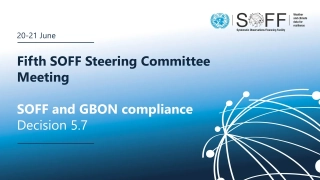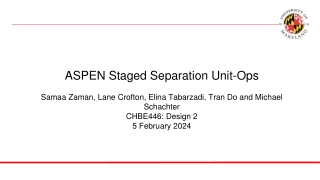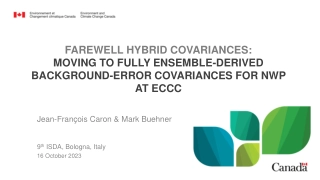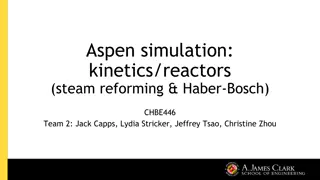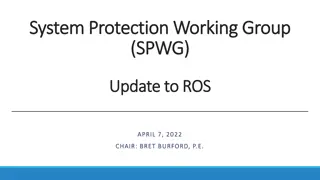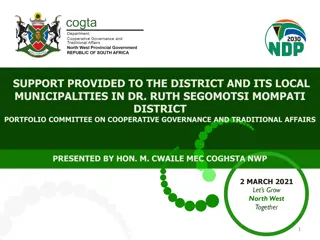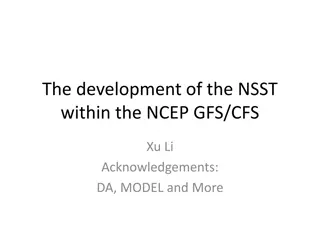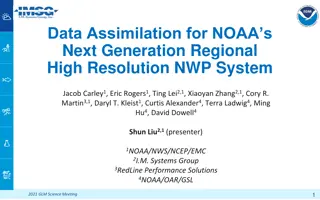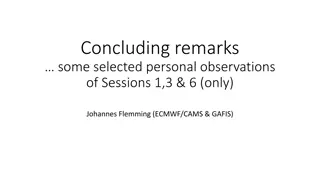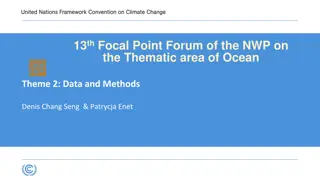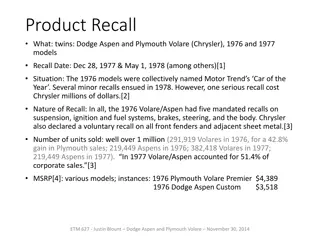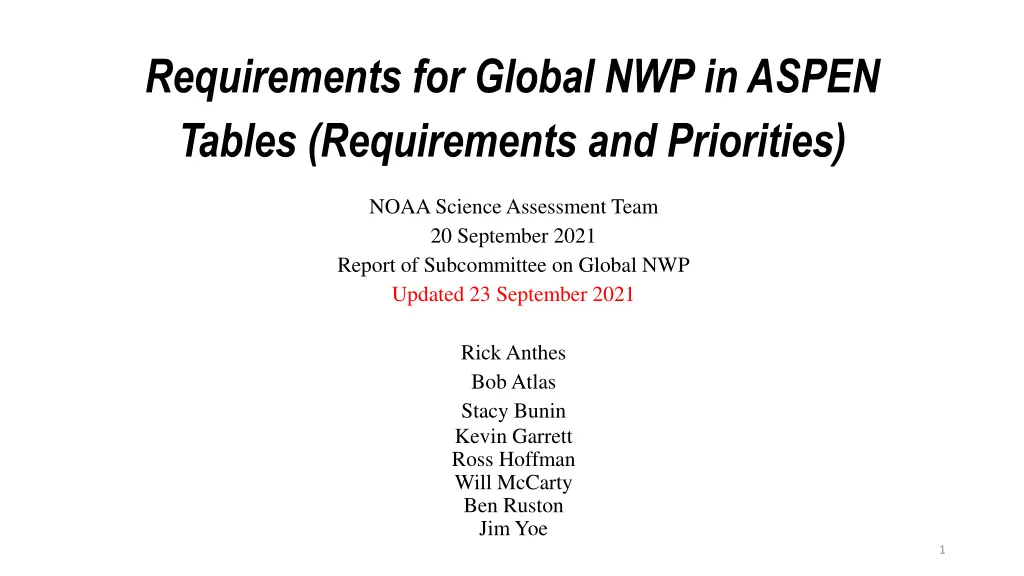
Global NWP Requirements and Priorities Study Findings
Explore the key findings from the report on global NWP requirements and priorities, including important objectives for the 2030 timeframe and realistic attribute ranges. Discover recommendations for updating the ASPEN tables and addressing inconsistencies in assumptions and priorities to enhance forecasting capabilities.
Download Presentation

Please find below an Image/Link to download the presentation.
The content on the website is provided AS IS for your information and personal use only. It may not be sold, licensed, or shared on other websites without obtaining consent from the author. If you encounter any issues during the download, it is possible that the publisher has removed the file from their server.
You are allowed to download the files provided on this website for personal or commercial use, subject to the condition that they are used lawfully. All files are the property of their respective owners.
The content on the website is provided AS IS for your information and personal use only. It may not be sold, licensed, or shared on other websites without obtaining consent from the author.
E N D
Presentation Transcript
Requirements for Global NWP in ASPEN Tables (Requirements and Priorities) NOAA Science Assessment Team 20 September 2021 Report of Subcommittee on Global NWP Updated 23 September 2021 Rick Anthes Bob Atlas Stacy Bunin Kevin Garrett Ross Hoffman Will McCarty Ben Ruston Jim Yoe 1
Tasks Tasks Which objectives (variables) and attributes are most important for global NWP in the 2030 time frame? A baseline for Monte-Carlo experiments or modified for another date (e.g. 2050). What are realistic1 ranges for the attributes (accuracy, resolution, etc.) for these objectives? Prepare for NOAA Program Level Requirements (PLR). Update draft values in ASPEN Application Requirements Ranges (ARR) and Application Technical Priorities (ATP) Tables. Suggest modifications to ASPEN Requirements table (ARR). The most important aspect of this study! 1 The middle range of performance (Expected) should be possible and affordable by 2030. The top end best case may be blue sky. 2
STUDY ASSUMPTIONS STUDY ASSUMPTIONS Global NWP only-medium-range forecasting-1-14 days. Global coverage requirements and attributes may be different for regional models such as HWRF. Assumes zero base. An important difference from NSOSA/SPRWG which assumed priorities based on improvements to current system. Technology agnostic-don t say how to meet the requirements or make observations. Very important do not consider existing technologies. These observations and their attributes are what global models require, regardless of where they come from or how. Different observing systems can contribute in different ways to meet these requirements, but that is not the concern of this study. All weather capability-clear, cloudy, and precipitating regions For this preliminary study, assumes vertical domain is troposphere (roughly 0-10 km). Later studies may consider boundary layer, stratosphere, and mesosphere, ionosphere (space weather). 3
Most important results from this study We suggest improvements to the ASPEN table. There are currently inconsistencies with the assumptions and some redundancies that should be addressed before additional studies or refinement of the priorities and performance attributes are made. We estimated the priorities of the most important variables (objectives) for global NWP and a range of performance attributes, ranging from Maximum Effective or best case to Expected to Minimally useful. The ASPEN requirements tool should be tested using reasonable values of priorities and performance attributes and Monte Carlo tests of the sensitivity of the ASPEN results to the input. Results of these tests should be reviewed carefully before tweaking the priorities or attribute values. "We want to know how the uncertainty in the process compares with the uncertainty in the input before spending too much time on the input. (Jim Yoe) 4
Current ASPEN Objectives (variables) for Current ASPEN Objectives (variables) for Global NWP Global NWP 55 total Atmosphere Biosphere Cryosphere Hydrosphere Ocean Most are of second or lower order importance currently and we will not consider these. A notable absence is surface pressure, which is very important for global NWP. (Sfc pressure alone can be sufficient for reanalyses- Slivinski et al. QJRMS, 2019 https://doi.org/10.1002/qj.3598) 29 7 7 5 7 5
Attributes in ASPEN ARR Tables Attributes in ASPEN ARR Tables (Current and New definitions adopted by subcommittee) (Current and New definitions adopted by subcommittee) Horizontal resolution Current: GIFOV (ground-projected instantaneous field of view) Issue: this is footprint, and is related to a specific technology (imagery) New: DX-average spacing between independent observations in km. Assumes uniform coverage. This dfn consistent with SPRWG, OSCAR, COURL and Boukabara et al (IEEE, 2021). 6
Attributes in ASPEN ARR Tables Attributes in ASPEN ARR Tables (Current and New definitions adopted by subcommittee) (Current and New definitions adopted by subcommittee) Vertical resolution Current: Nv independent pieces of information in one GIFOV, degrees of freedom of information d.o.f. Issue: should be defined for a layer of specified thickness. Currently a single layer with a range of bottoms and tops is required, which can produce unreasonable combinations (e.g. a d.o.f. of 3 and vertical layer of 100 km gives a vertical resolution Z=33.3 km). New: Replace columns J and K (Eb and Et) by a new column (attribute) called Vertical Domain, or Dv. For now this is troposphere or 0-10 km (which is roughly 90% of atmosphere). Several Dv could be added later as is in OSCAR or COURL. Define vertical resolution as Dv/d.o.f. (it is meaningful to define vertical resolution in terms of d.o.f. rather than number of reported levels, for example) 7
Attributes in ASPEN ARR Tables Attributes in ASPEN ARR Tables (Current and New definitions adopted by subcommittee) (Current and New definitions adopted by subcommittee) Uncertainty (precision) Current: accuracy (error standard deviation) over vertical layers, clear and cloudy, over different surface backgrounds. Issue: This is precision rather than accuracy. (SPRWG also had this same issue). Otherwise definition ok. 8
Attributes in ASPEN ARR Tables Attributes in ASPEN ARR Tables (Current and New definitions adopted by subcommittee) (Current and New definitions adopted by subcommittee) Temporal refresh (update rate) Current: time between obs at a point, i.e. time to observe the geographic region in seconds. (OK, no change) Data latency (hours) Current: Time from which image is taken to full relay to a ground station. Issue: Not the latency that is important to NWP and is related to a specific technology (imagery). New: median time from when an observation is made to the time it is processed and received at NWP centers. (This is what matters for NWP) 9
Footprints: Definition and considerations Footprints: Definition and considerations Horizontal and vertical footprints: Scales of information represented by a single observation. Sometimes called horizontal resolution of a single observation. In imagery GIFOV, ground sampling distance (GSD) or pixel size. Large variation in footprints in technologies Radiosondes have very small horizontal and vertical footprint (points) IR and MW: horiz footprint of 5-25 km and vert footprint of 1-3 km RO: horizontal footprint of ~200 km and vertical footprint ~150 m Best footprint for models depends on horizontal and vertical grid sizes. Footprints depend on specific models and technologies and are redundant with horizontal resolution for some technologies; we do not consider them . 10
Horizontal wind profiles Horizontal wind profiles We recommend specifying wind as one objective (vector wind V) rather than separate objectives for U and V. U and V are not independent Other requirements studies use vector winds as objective No observing system we can think of measures one and not the other Uncertainty can be expressed in terms of V (m/s) or V/V (%) where V is the magnitude of V and V is the magnitude of V. We do both here. 11
Priorities Priorities Highest priority = 1 Low priority = 0.1 (minor importance today, may be more important in future) Placeholder = 0.05 (little importance today, may be more important in future, e.g. upper ocean temperature, vegetation index ) Temperature profiles Winds (V) profiles Sfc pressure RH profiles and winds; impact of initial conditions decreases rapidly with fcst time. Near surface boundary variable that change on a daily or less cadence, e.g. SST, sea ice concentration, snow cover) 0.2 (some members preferred 0.1) Many others . Less than 0.1. We decided to go with Ross preliminary estimates, perhaps as modified by him from this discussion and consultation with OSCAR, for this study. 1.0 1.0 0.8 (Uncertain-need further study) 0.6 (0.5-0.8 were discussed). Lower than temperature 12
Temperature Attributes Temperature Attributes OSCAR, SPRWG, and OSCAR, SPRWG, and suggested ASPEN values suggested ASPEN values Horiz resol (km) OSCAR (15, 100, 500) SPRWG IR (1, 10, 150 SAT (1, 50, 100) Vertical resolution in troposphere (0-10 km) OSCAR (free troposphere) (0.3, 0.5, 1.0) SPRWG IR (1.0, 1.5, 2) SAT (0.3, 1.0, 2.0) Uncertainty (K) OSCAR (0.5, 1.0, 3.0) SPRWG IR (0.5, 0.75, 1.0) SAT (0.5, 1.0, 2.0) Refresh rate (h) OSCAR (1, 6, 12) SPRWG IR (1, 3, 12) SAT (0.5, 3, 12) Latency (h) OSCAR (6 min, 0.5, 6.0) SPRWG IR (15 min, 1.0, 3.0) SAT (15 min, 1.0, 3.0) 13
Relative Humidity Attributes Relative Humidity Attributes OSCAR and OSCAR and suggested ASPEN values suggested ASPEN values Horiz resol (km) OSCAR q (15, 50, 250) SAT (1, 50, 100) same as temperature Vertical resolution in troposphere (km) OSCAR (FT) (0.3, 0.5, 1.0) SAT (0.3, 1.0, 5.0 ) Uncertainty (%) (Example: RH of 50% +/- 10% = RH in range 45% to 55%) OSCAR q (2.0, 5.0, 10.0) SAT (5.0, 10.0, 15.0) Refresh rate (h) OSCAR q (1, 6, 12) SAT (0.5, 3, 12) same as temperature Latency (h) OSCAR q (6 min, 0.5, 6.0) SAT (15 min, 1.0, 3.0) same as temperature 14
Wind (vector wind V V) Attributes OSCAR and OSCAR and ASPEN values ASPEN values Horiz resol (km) OSCAR (15, 100, 500) SAT (1, 50, 100 ) same as temperature Vertical resolution in troposphere (km) OSCAR (FT) (0.5, 1.0, 3.0) SAT (0.5, 1.0, 3.0) Uncertainty (% or m/s) OSCAR Free troposphere (1.0, 3.0, 8.0 m/s) SAT (5%, 10%, 20%) (correspond to 1 m/s, 2 m/s and 4 m/s for a typical tropospheric wind speed of 20 m/s) Refresh rate (h) OSCAR (1, 6, 12) SAT (0.5, 3, 12) same as temperature Latency (h) OSCAR (6 min, 0.5, 6.0) SAT (15 min, 1.0, 3.0 ) 15
Attributes of other lower priority variables We decided to leave previous values inserted by Ross Hoffman. Ross may make changes to make them consistent with our discussion. For example latency could be made the same for temperature, wind and humidity for all objectives. Alternative: adopt OSCAR values for all of them. Would require significant effort, no time for this and not important at this stage. 16
Attributes in ASPEN ARR Tables Attributes in ASPEN ARR Tables Redundant or technology dependent Redundant or technology dependent Will not specify in this study Will not specify in this study Horizontal density-number of obs per 100x100 km box (redundant when geographic region and horizontal resolution are defined) Robustness (number of satellites/instruments) part of specific technological solution, a strategic objective. Validity of range (high and low) (e.g. instrument valid over -20K to +20K)-a function of technology Continuity-length of time available for calibration purposes, function of technology. 18
Process Process Subcommittee met for 1.5 hours on 31 Aug and again on 14 Sept 2021. Discussion via email throughout. Started with Priorities Table Overall priorities of variables (e.g. temperature, water vapor, winds) For each objective, a range of performance attributes (low, medium, high) To be done later: For each objective, the relative priority of attributes (e.g. global coverage, horizontal resolution, uncertainty). This brief study is a test of the process and ASPEN, and will be reviewed by the full SAT. No need to be precise. A reasonable first cut is fine. Error bars of +/- 25% on our numbers. Discussed with SAT on 20 September and revised slightly afterwards 19
We already know a lot! We already know a lot! Previous studies on requirements and priorities WMO OSCAR https://space.oscar.wmo.int/requirements NOAA-TPIO COURL https://nosc.noaa.gov/tpio/main/aboutrap.html NSOSA-SPRWG https://doi.org/10.1175/BAMS-D-18-0180.1 WMO WIGOS Space Vision 2040 (2019) and WMO Rolling Review of Requirements OSEs, OSSES, and FSOI impact studies by independent centers Surface pressure and 3D (X,Y,Z) observations of temperature, water vapor and winds are most important in today s models. But other observations are still essential- sea surface temperature, sea ice, . Most important: a balance of observation types is needed, and there is a current imbalance, so that the greatest priority for improvement is wind observations. My presentation at the Sept. 23 SAT meeting gives details-available on the SAT shared Drive or from me. The ECMWF annual seminars 13-17 Sept 2021 also have a lot of valuable up-to-date information on impacts. 20
Horizontal resolution, obs density and number NH=104/DX2 for global coverage DX (km) 500 250 100 50 25 10 5 2 1 NH (number of obs per 100x100 km box) 0.04 0.16 1 4 16 100 400 2,500 10,000 Total number of obs for global coverage (5.1x104N) 2040 8160 51 x103 204 x103 816 x103 5100 x103 20,400 x103 127,500 x103 510,000 x103 (510 million observations)1 1This is one level only. For a vertical resolution of 250 m over 0-25 km (100 levels) this would be 51,000 million. For comparison, ERA5 assimilates about 25 million obs/per day. 21
Implications of horizontal resolution Implications of horizontal resolution Rapid increase in number of obs as horizontal resolution increases Costs ($) more sensors/satellites needed as DX decreases. Cost in processing, communication SNR-as scale decreases, so does signal-amplitude of very short waves smaller than amplitude of medium- and larger-scale waves, requires smaller uncertainties. Time scale of small-scale features decreases, requires faster update rates and lower latency 22
Impact of assimilating land observations on forecast skill in NWP systems is often positive, but very small (e.g., Draper et al., 2012, Rodriguez-Fernandez et al. 2019, Carrera et al., Reichle et al. in review) 23
Some Final Comments from Rick on priorities The question "which are more important, wind or temperature observations" is an ill-posed question because both are important and the relative importance depends on the number of observations, their quality, horizontal and vertical resolution, update rate, latitude, and the data assimilation procedure used. A better question would be "Given a fixed amount of resources, what is an optimal mix of wind, temperature, water vapor and other variables for global NWP? Or, as we did for NSOSA/SPWRG, what are the priorities for global NWP improvement in the current global observing system? The latter two are better constrained and more useful. 24

